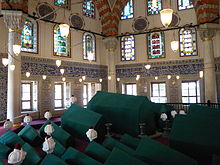Safiye Sultan
| Safiye Sultan صفیه سلطان |
|
|---|---|

The türbe of Safiye is located next to that of Murad III in the courtyard of Hagia Sophia
|
|
| Valide Sultan of the Ottoman Empire | |
| Tenure | 15 January 1595 – 22 December 1603 |
| Predecessor | Nurbanu Sultan |
| Successor | Handan Sultan |
|
Haseki Sultan of the Ottoman Empire (Imperial Consort) |
|
| Tenure | c.1575 – 15 January 1595 |
| Predecessor | Nurbanu Sultan |
| Successor | Kösem Sultan |
| Born |
c. 1550 Dukagjin highlands (currently the territory of Albania) |
| Died |
c. 1619 (aged 68-69) Eski Palace, Bayezid, Istanbul, Ottoman Empire |
| Burial | Mausoleum of Murad III, Hagia Sophia Mosque, Istanbul |
| Spouse | Murad III |
| Issue |
Mehmed III Şehzade Mahmud Ayşe Sultan Fatma Sultan |
| Religion | Islam, previously Roman Catholic |
Safiye Sultan (Ottoman Turkish: صفیه سلطان; c. 1550 – 1619), was the consort of Murad III and Valide Sultan of the Ottoman Empire as mother of Mehmed III. Safiye was also one of the eminent figures during the era known as the Sultanate of Women. She lived in the Ottoman Empire during the reigns of seven sultans, Suleiman the Magnificent, Selim II, Murad III, Mehmed III, Ahmed I, Mustafa I, and Osman II.
The identity of Safiye has often been confused with that of her Venetian mother-in-law, Nurbanu, leading some to believe that Safiye was also of Venetian descent. However, Safiye was of Albanian origin, born in the Dukagjin highlands.
In 1563, at the age of 13, she was presented as a slave to the future Murad III by Hümaşah Sultan, daughter of Şehzade Mehmed, son of Suleiman the Magnificent and Hürrem Sultan. Given the name Safiye ("the pure one"), she became a concubine of Murad (then the eldest son of Sultan Selim II). In 26 May 1566, she gave birth to Murad's son, the future Mehmed III, same year when Suleiman the Magnificent died.
Safiye had been Murad's only concubine prior to his accession, and he continued having a monogamous relationship with her for several years into his sultanate. His mother Nurbanu advised him to take other concubines for the good of the dynasty, which by 1581 had only one surviving heir, Murad and Safiye's son Mehmed. In 1583, Nurbanu accused Safiye of using witches and sorcerers to render Murad impotent and prevent him from taking new concubines. This resulted in the imprisonment and torture of Safiye's servants. Murad's sister Esmehan presented him with two beautiful concubines, which he accepted. Cured of his impotence, he went on to father twenty sons and twenty-seven daughters.
...
Wikipedia
